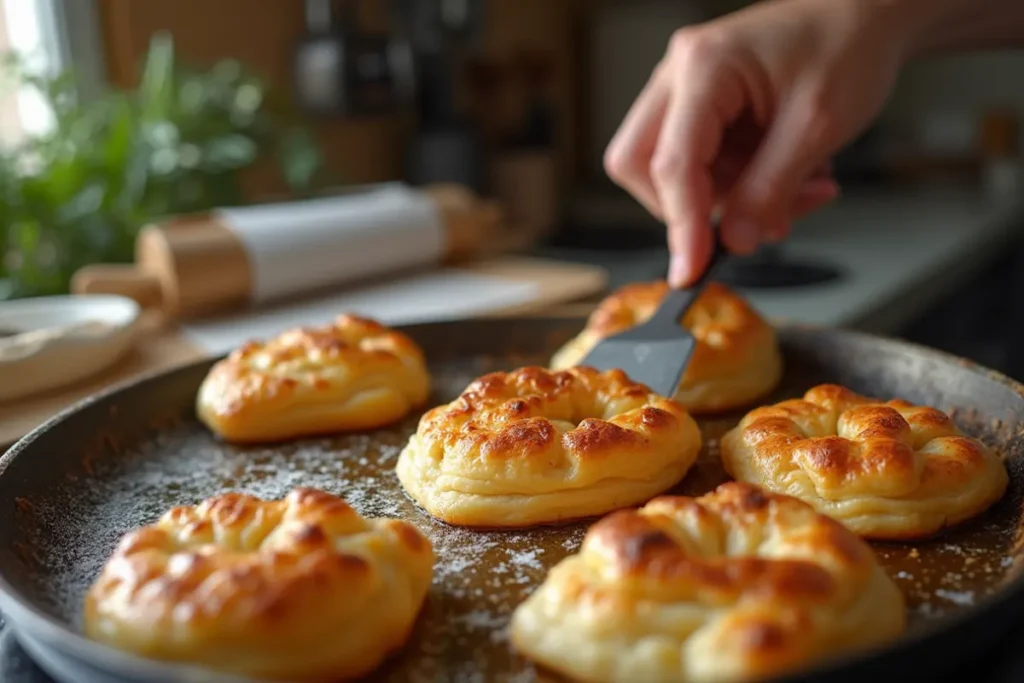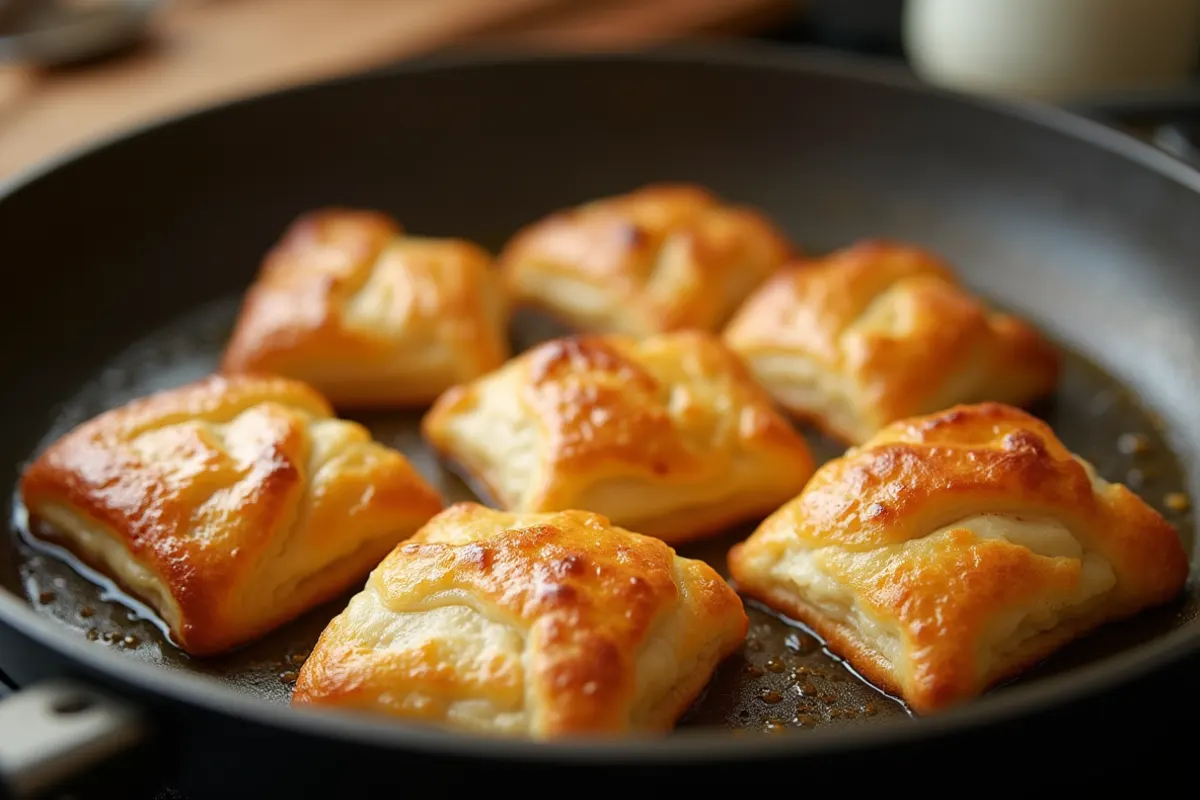Introduction: A Crispy Dream Come True
Imagine this: You’ve just pulled a tray of golden-brown puff pastry out of the oven. It’s flaky, light, and perfectly crisp, just as you’ve always known it. But what if there was a way to take that classic, already delicious pastry and elevate it even further? What if you could fry puff pastry and create a whole new experience—one that is even crispier, more indulgent, and perhaps more exciting than the baked version?
If you’ve ever found yourself asking, “Can you fry puff pastry?” you’re not alone. Many people have wondered whether this simple, versatile pastry dough can be transformed into something even more extraordinary through frying. The answer is yes! And in this article, we’re going to walk you through everything you need to know about frying puff pastry—whether you’re after a quick snack, a savory appetizer, or a sweet treat. We’ll also explore some expert tips, recipe ideas, and important things to keep in mind when frying puff pastry to ensure the best results.
Can You Fry Puff Pastry? Exploring the Possibilities
What Happens When You Fry Puff Pastry?
When you fry puff pastry, the magic truly happens. The pastry’s delicate layers quickly cook in hot oil, resulting in a crisp, golden-brown exterior. The layers of dough, which are traditionally created by folding butter into the dough to form multiple layers, puff up when exposed to the hot oil. The result? A crunchy, crispy shell with a light, airy interior.
In this section, we’ll dive into the specific changes that occur when puff pastry is fried and how it differs from the traditional baking method.
Texture Transformation
Frying puff pastry changes the texture in a significant way. Unlike baking, which creates a lightly crisped crust, frying produces an ultra-crisp exterior with a wonderfully airy interior. The layers of dough puff up more than they would in the oven, thanks to the immediate heat of the oil.
Flavor Intensification
The heat from the oil cooks the butter inside the puff pastry quickly, intensifying its flavor. The outside becomes beautifully golden, adding a richness that complements both sweet and savory fillings. Fried puff pastry can have a buttery, slightly savory flavor, depending on the ingredients you add.
Comparison with Baking
When puff pastry is baked, it tends to create a more delicate, flaky texture. However, frying the pastry creates a satisfying crunch that makes it a whole new experience. Fried puff pastry also cooks faster than baked, which can make it a great option when you’re looking for a quick snack.
Types of Puff Pastry That Are Ideal for Frying
Not all puff pastry is created equal, and certain types of dough work better than others when it comes to frying. In this section, we’ll talk about the different types of puff pastry and which ones will give you the best results when fried.
Store-Bought vs. Homemade Puff Pastry
While homemade puff pastry can deliver fantastic results when fried, store-bought puff pastry is often more convenient and yields great results, especially when you’re short on time. When purchasing store-bought puff pastry, opt for a high-quality brand with butter as a main ingredient. This will give you the best flavor and texture when frying.
Which Puff Pastry Brands Are Best for Frying?
Some of the best store-bought puff pastry brands for frying include:
- Pepperidge Farm: Known for its high-quality, buttery flavor.
- Dufour Pastry Kitchens: Offers all-butter puff pastry for a richer taste.
- Trader Joe’s: Known for its affordable and convenient puff pastry options.
Frozen Puff Pastry: Can it Be Fried?
Yes, frozen puff pastry can be fried. In fact, it’s a great option for convenience. Simply thaw it in the refrigerator overnight or at room temperature for about 30 minutes before using. The pastry should be slightly chilled but not too soft before frying. Thawing it helps to avoid excessive oil absorption during frying, keeping the texture light and crispy.
Step-by-Step Guide to Frying Puff Pastry

Now that you understand the science behind frying puff pastry, it’s time to walk through the steps of making your own crispy, golden treat. This simple step-by-step guide will show you how to fry puff pastry, ensuring perfect results every time.
Ingredients You’ll Need:
| Ingredient | Quantity |
|---|---|
| Puff Pastry | 1 sheet |
| Oil (vegetable or canola) | Enough to submerge pastry |
| Sugar (optional) | For dusting, 1-2 tbsp |
| Salt (optional) | Pinch for savory dishes |
Instructions:
- Prepare the Puff Pastry: If you’re using store-bought, make sure the puff pastry is thawed completely. For homemade puff pastry, roll it out to your desired thickness (usually about 1/8-inch thick).
- Cut into Shapes: Slice the pastry into strips, squares, or any shape you prefer. Keep in mind that smaller pieces will cook faster than larger ones.
- Heat the Oil: In a deep frying pan or fryer, heat the oil to 350°F (175°C). The oil should be deep enough to allow the pastry to float while cooking. Use a thermometer to keep the oil at the correct temperature.
- Fry the Pastry: Carefully place the cut pastry into the hot oil. Fry in batches if necessary to avoid overcrowding. Fry each piece for about 1-2 minutes, or until golden brown and puffed up. Turn the pieces halfway through to ensure even frying.
- Drain and Serve: Remove the pastry from the oil and place it on a plate lined with paper towels to drain excess oil. Optionally, dust with powdered sugar or a sprinkle of salt for extra flavor.
Tips for Perfectly Fried Puff Pastry
Frying puff pastry may seem straightforward, but there are some key tips that will ensure your results are perfect every time.
Control the Temperature
Maintaining the correct temperature is crucial. If the oil is too hot, the pastry will burn on the outside before it cooks through. If the oil is too cool, the pastry will absorb too much oil, resulting in greasy, heavy pieces. The ideal temperature for frying puff pastry is between 350°F and 375°F.
Don’t Overcrowd the Pan
Frying in small batches is essential. Overcrowding the pan will lower the temperature of the oil, leading to uneven cooking and a soggy result. Frying in batches ensures each piece of puff pastry gets the attention it deserves.
Watch the Timing
Fried puff pastry cooks incredibly fast. Keep a close eye on your pastry while frying, as it can go from perfectly golden to overcooked in just a few seconds.
Savory and Sweet Variations of Fried Puff Pastry
Fried puff pastry is incredibly versatile, making it the perfect base for both sweet and savory dishes. Here are some creative variations you can try.
Fried Puff Pastry Desserts
- Fried Apple Turnovers: Fill puff pastry with spiced apples, fry, and dust with powdered sugar.
- Chocolate-Filled Pastries: Add a piece of your favorite chocolate bar, fry, and enjoy gooey, melted chocolate inside a crispy pastry.
- Cinnamon Sugar Puff Pastry: After frying, toss the pastry in cinnamon sugar for a delightful, sweet snack.
Fried Puff Pastry for Savory Dishes
- Cheese-Stuffed Pastries: Place cheese inside the puff pastry and fry for a cheesy, crispy snack.
- Mini Fried Hand Pies: Stuff the pastry with savory fillings like spinach, feta cheese, or roasted vegetables.
Creative Fillings for Fried Puff Pastry
The possibilities are endless when it comes to fillings. Try some of these creative ideas:
- Caramelized onions and goat cheese
- Spicy chicken with avocado
- Spinach and ricotta cheese
- Lemon and ricotta curd
Health Considerations: Is Fried Puff Pastry a Healthy Choice?
While fried puff pastry is undeniably delicious, it’s important to be mindful of its nutritional content. Frying increases the fat content, which means that while it’s a tasty treat, it’s best enjoyed in moderation.
Calories in Fried Puff Pastry
Fried puff pastry can be quite calorie-dense. The exact calorie count will depend on the size of the pastry and the amount of oil absorbed during frying, but expect a fried pastry to have at least 100-150 calories per serving.
Nutritional Comparison: Fried vs. Baked Puff Pastry
Baked puff pastry is typically lower in fat and calories than fried puff pastry, but it lacks the crispy texture that frying imparts. If you’re looking for a lighter alternative, try baking the puff pastry with a small amount of oil spray.
Healthier Alternatives
For those who want to reduce the oil content, consider air-frying puff pastry. The air fryer uses hot air to cook the pastry, giving you a crispy result with much less oil.
Troubleshooting Common Problems When Frying Puff Pastry
Even experienced cooks encounter issues from time to time. Here are a few common problems you might run into when frying puff pastry, along with solutions to fix them.
Pastry Too Oily
If your puff pastry turns out greasy, it may have absorbed too much oil. This can happen if the oil temperature is too low or if you overcrowd the pan. To prevent this, always ensure the oil is hot enough before frying and avoid overloading the pan.
Not Puffing Up
Sometimes, puff pastry doesn’t puff up as expected. This can happen if the dough is too thick or if the oil isn’t hot enough. Make sure to roll the dough to the right thickness and monitor the oil temperature carefully.
Burning Too Quickly
If the pastry is burning, the oil may be too hot. Use a thermometer to maintain the correct frying temperature. You can also try turning the heat down slightly to ensure even cooking.
Frequently Asked Questions (FAQs)
Can you fry puff pastry without any filling?
Yes, you can fry puff pastry without filling. In fact, fried puff pastry without filling is a delicious, crispy treat on its own. Simply fry the dough and sprinkle it with sugar for a sweet snack or salt for a savory bite.
What’s the best oil for frying puff pastry?
Vegetable oil, canola oil, or sunflower oil are great options for frying puff pastry. These oils have high smoke points, which help achieve a crisp, golden result without burning the pastry.
Can you fry puff pastry in an air fryer?
Yes, you can use an air fryer to cook puff pastry! The air fryer gives you a crisp result with less oil, although it may not puff up quite as much as traditional deep frying.
Is fried puff pastry a healthy snack?
Fried puff pastry is a delicious treat but not the healthiest option due to its high fat and calorie content. Consider eating it in moderation or trying healthier alternatives like air-frying or baking with less oil.
How do you store leftover fried puff pastry?
Store leftover fried puff pastry in an airtight container at room temperature for up to 2 days. If you want to store it for longer, you can freeze the pastries for up to a month. Reheat in an oven to restore its crispiness.
Can puff pastry be fried in a pan or deep fryer?
Both methods work well! You can fry puff pastry in a pan with enough oil to submerge the pastry halfway or in a deep fryer for quicker, more even cooking.
Conclusion: Frying Puff Pastry – A Game-Changer for Your Culinary Repertoire
Frying puff pastry adds a whole new layer of flavor and texture to an already fantastic dish. Whether you’re looking to create savory snacks, sweet treats, or a fun twist on a classic, fried puff pastry opens up a world of possibilities. By following the right techniques and using the best ingredients, you can create perfectly fried puff pastry that is crispy, golden, and absolutely delicious.
Next time you’re craving something crunchy and indulgent, consider frying up a batch of puff pastry. You won’t regret it!

